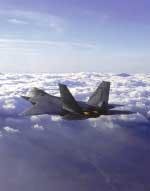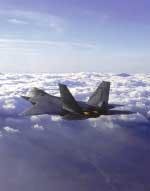by John McHale
MERRIMACK, N.H. - Engineers at BAE Systems Information & Electronic Warfare Systems (IEWS) are continuing to deliver on budget and on time the electronic warfare system for the U.S. Air Force F-22 Raptor, mainly due to a diminishing manufacturing sources (DMS) team the company formed about a decade ago to manage the plethora of obsolescence problems associated with 15- to 20-year military platforms.
The DMS part of the program is "really slick," says Mike Dow, operations director for the F-22/Joint Strike Fighter (JSF) business unit at BAE Systems IEWS. "Most of the electronics on the F-22 started out as custom designs" but are migrating toward commercial-off-the-shelf (COTS) technology as parts become obsolete and need to be upgraded, he explains.
IEWS experts provide the F-22 electronic warfare system, which is a part of the aircraft's advanced sensor capabilities that include 19 distinct antennas. The company will also provide the fighter's airborne videotape recorders, communication, navigation, and instrumentation (CNI), graphics processor video interface, operational debrief system, stores management, modules, and mission support software.
IEWS officials formed a DMS team that manages obsolescence by replacing parts that are no longer available, Dow says. The electronics suite also uses an open architecture to facilitate upgrades to the latest technology.
IEWS experts will then apply the same practice to their work on the Joint Strike Fighter contract, Dow says. It may not be the same technology, but IEWS engineers will leverage off the work they did for the F-22 onto the JSF, he explains. The future JSF is a stealthy, supersonic, multi-role fighter designed for the U.S. Air Force, Navy and Marine Corps, as well as the U.K. Royal Air Force and Royal Navy.
Back in 1991 IEWS officials were told they had figure out a way to design an electronics suite that could last 15 to 20 years and be efficiently able to upgrade the system as parts became obsolete, Dow says. "We all looked on in horror," he continues. This was a difficult task especially as the 1990s progressed and more and more COTS technology was designed in, Dow adds.
Obsolescence is the bane of COTS. Today many COTS devices such as processors can be have a shelf life of anywhere from six to 18 months.
When parts are no longer available solutions can run from respinning a board, putting a part in a footprint, or even the expensive effort of redesigning an entire module, Dow says. We also do lifetime buys but for smaller, more essential systems, he adds.
Being able to react quickly when a part goes obsolete is a result of good planning, which is why block programs or scheduled upgrades have significantly helped to mitigate obsolescence, Dow says. This allows for earlier versions of a product to be fielded and still be on an upgrade path for the latest technology, he explains.
The F-22 electronics suite's digital receiver is an excellent example of this, Dow says. The receiver was a single part that replaced multiple obsolete parts during a scheduled upgrade, he explains.
It is difficult to predict the future and when parts will go obsolete but block programs are an excellent way of planning ahead and keeping a technology up to date, Dow says.
IEWS experts have been involved in the F-22 Program and the INEWS legacy functionality for nearly 15 years. In addition to avionics elements, the group is responsible for the Raptor's mission planning system, which is based on the AFMSS core - the Air Force standard mission planning system, BAE systems officials say.
IEWS officials recently broke ground on a new Antenna composite manufacturing Facility in Merrimack that occupies more than 30,000 square feet and is home to composites manufacturing for the F-22 and future work for the JSF.
The F-22 Raptor, the world's first stealthy air dominance fighter, is built by Lockheed Martin Aeronautics in Marietta, Ga., and Fort Worth, Texas in partnership with Boeing in Seattle.
The Raptor will replace the F-15 Eagle as America's premier front-line fighter jet starting in 2005.




